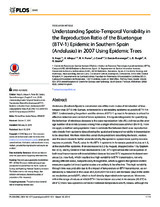Mostrar el registro sencillo del ítem
Understanding Spatio-Temporal Variability in the Reproduction Ratio of the Bluetongue (BTV-1) Epidemic in Southern Spain (Andalusia) in 2007 Using Epidemic Trees
| dc.contributor.author | Napp, Sebastián | |
| dc.contributor.author | Allepuz, Alberto | |
| dc.contributor.author | Purse, B.V. | |
| dc.contributor.author | Casal, Jordi | |
| dc.contributor.author | García-Bocanegra, Ignacio | |
| dc.contributor.author | Burgin, L.E. | |
| dc.contributor.author | Searle, K.R. | |
| dc.date.accessioned | 2017-11-30T13:07:06Z | |
| dc.date.available | 2017-11-30T13:07:06Z | |
| dc.date.issued | 2016 | |
| dc.identifier.uri | http://hdl.handle.net/10396/15611 | |
| dc.description.abstract | Andalusia (Southern Spain) is considered one of the main routes of introduction of bluetongue virus (BTV) into Europe, evidenced by a devastating epidemic caused by BTV-1 in 2007. Understanding the pattern and the drivers of BTV-1 spread in Andalusia is critical for effective detection and control of future epidemics. A long-standing metric for quantifying the behaviour of infectious diseases is the case-reproduction ratio (Rt), defined as the average number of secondary cases arising from a single infected case at time t (for t>0). Here we apply a method using epidemic trees to estimate the between-herd case reproduction ratio directly from epidemic data allowing the spatial and temporal variability in transmission to be described. We then relate this variability to predictors describing the hosts, vectors and the environment to better understand why the epidemic spread more quickly in some regions or periods. The Rt value for the BTV-1 epidemic in Andalusia peaked in July at 4.6, at the start of the epidemic, then decreased to 2.2 by August, dropped below 1 by September (0.8), and by October it had decreased to 0.02. BTV spread was the consequence of both local transmission within established disease foci and BTV expansion to distant new areas (i.e. new foci), which resulted in a high variability in BTV transmission, not only among different areas, but particularly through time, which suggests that general control measures applied at broad spatial scales are unlikely to be effective. This high variability through time was probably due to the impact of temperature on BTV transmission, as evidenced by a reduction in the value of Rt by 0.0041 for every unit increase (day) in the extrinsic incubation period (EIP), which is itself directly dependent on temperature. Moreover, within the range of values at which BTV-1 transmission occurred in Andalusia (20.6°C to 29.5°C) there was a positive correlation between temperature and Rt values, although the relationship was not linear, probably as a result of the complex relationship between temperature and the different parameters affecting BTV transmission. Rt values for BTV-1 in Andalusia fell below the threshold of 1 when temperatures dropped below 21°C, a much higher threshold than that reported in other BTV outbreaks, such as the BTV-8 epidemic in Northern Europe. This divergence may be explained by differences in the adaptation to temperature of the main vectors of the BTV-1 epidemic in Andalusia (Culicoides imicola) compared those of the BTV-8 epidemic in Northern Europe (Culicoides obsoletus). Importantly, we found that BTV transmission (Rt value) increased significantly in areas with higher densities of sheep. Our analysis also established that control of BTV-1 in Andalusia was complicated by the simultaneous establishment of several distant foci at the start of the epidemic, which may have been caused by several independent introductions of infected vectors from the North of Africa. We discuss the implications of these findings for BTV surveillance and control in this region of Europe. | es_ES |
| dc.format.mimetype | application/pdf | es_ES |
| dc.language.iso | eng | es_ES |
| dc.publisher | Public Library of Science | es_ES |
| dc.rights | https://creativecommons.org/licenses/by-nc-nd/4.0/ | es_ES |
| dc.source | PLoS ONE 11(3): e0151151 (2016) | es_ES |
| dc.subject | Bluetongue virus | es_ES |
| dc.subject | Infectious disease epidemiology | es_ES |
| dc.subject | Colicoides | es_ES |
| dc.subject | Infectious disease control | es_ES |
| dc.subject | Europe | es_ES |
| dc.subject | Sheep | es_ES |
| dc.title | Understanding Spatio-Temporal Variability in the Reproduction Ratio of the Bluetongue (BTV-1) Epidemic in Southern Spain (Andalusia) in 2007 Using Epidemic Trees | es_ES |
| dc.type | info:eu-repo/semantics/article | es_ES |
| dc.relation.publisherversion | http://dx.doi.org/10.1371/journal.pone.0151151 | es_ES |
| dc.relation.projectID | info:eu-repo/grantAgreement/EC/FP7/261504 (EDENext) | es_ES |
| dc.rights.accessRights | info:eu-repo/semantics/openAccess | es_ES |

